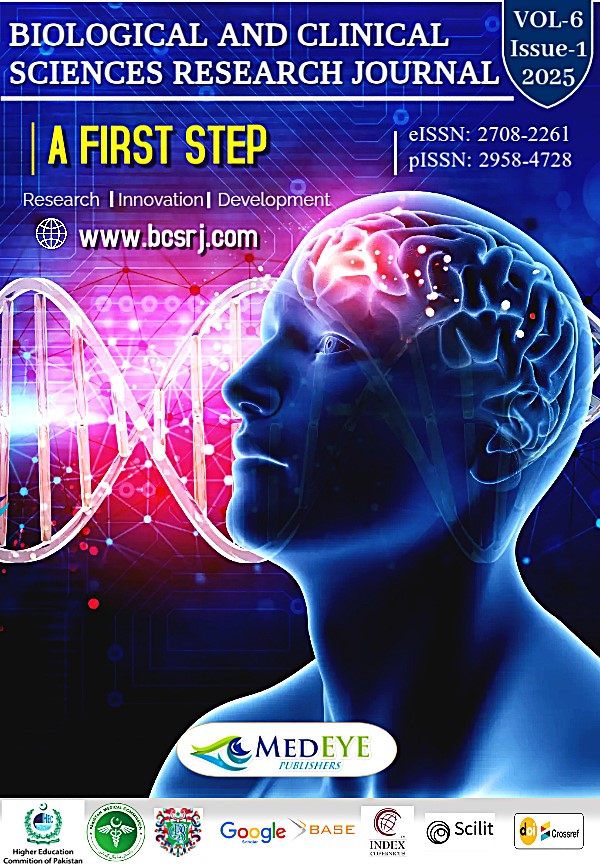Effectiveness of Intralesional Steroid Injections in Peyronie’s Disease
DOI:
https://doi.org/10.54112/bcsrj.v6i1.1508Keywords:
Peyronie’s Disease, Intralesional Steroid Injections, Penile Curvature, Plaque Size, Erectile Function, Pain Relief, Non-Surgical TreatmentAbstract
Peyronie’s disease (PD) is a progressive fibrotic disorder characterised by penile curvature, plaque formation, pain, and erectile dysfunction, significantly impacting patients' quality of life. Various treatment modalities, including intralesional steroid injections, have been explored to manage PD, but their efficacy remains a subject of investigation. Objective: This observational study aimed to evaluate the effectiveness of intralesional steroid injections in treating Peyronie’s disease. Methods: This observational study was conducted from January 2023 to December 2024, involving 101 male patients aged between 20 and 65. All patients were diagnosed with Peyronie’s disease based on clinical evaluation and medical history. Participants were treated with intralesional steroid injections administered every four weeks for a total of three sessions. Pre- and post-treatment assessments included measurements of penile curvature, plaque size, erectile function using the International Index of Erectile Function (IIEF), and pain levels using a visual analogue scale (VAS). The primary outcomes were changes in penile curvature, erectile function, plaque size and pain relief, with follow-up evaluations conducted after each treatment cycle. Results: Out of the 101 patients, 75.2% experienced improvements in penile curvature, and 61.4% showed a reduction in plaque size. Additionally, 64.4% of participants reported pain relief, and 77.2% exhibited improvements in erectile function, as measured by the IIEF score. Conclusion: Intralesional steroid injections were found to be effective in reducing penile curvature, plaque size, and pain, as well as improving erectile function in patients with Peyronie’s disease.
Downloads
References
Di Maida F, Cito G, Lambertini L, Valastro F, Morelli G, Mari A, et al. The natural history of Peyronie's disease. World J Men Health. 2021;39(3):399.
Nelson CJ, Diblasio C, Kendirci M, Hellstrom W, Guhring P, Mulhall JP. The chronology of depression and distress in men with Peyronie's disease. J Sex Med. 2008;5(8):1985-90.
Hartzell R. Psychosexual symptoms and treatment of Peyronie's disease within a collaborative care model. medicine. 2014;2(4):168-77.
DiBenedetti DB, Nguyen D, Zografos L, Ziemiecki R, Zhou X. A Population‐Based Study of Peyronie′ s Disease: Prevalence and Treatment Patterns in the United States. Adv Urol. 2011;2011(1):282503.
Gonzalez-Cadavid NF, Rajfer J. Mechanisms of disease: new insights into the cellular and molecular pathology of Peyronie's disease. Nat Clin Pract Urol. 2005;2(6):291-7.
Inal T, Tokatli Z, Akand M, Özdiler E, Yaman Ö. Effect of intralesional interferon-alpha 2b combined with oral vitamin E for treatment of early stage Peyronie’s disease: a randomized and prospective study. Urology. 2006;67(5):1038-42.
Gelbard MK, Dorey F, James K. The natural history of Peyronie’s disease. J Urol. 1990;144(6):1376-9.
Chung PH, Han TM, Rudnik B, Das AK. Peyronie’s disease: what do we know and how do we treat it?. Can J Urol. 2020;27(3):11-9.
Sharma KL, Alom M, Trost L. The etiology of Peyronie’s disease: pathogenesis and genetic contributions. Med Rev. 2020;8(2):314-23.
Gelbard M, Lipshultz LI, Tursi J, Smith T, Kaufman G, Levine LA. Phase 2b study of the clinical efficacy and safety of collagenase Clostridium histolyticum in patients with Peyronie disease. J Urol. 2012;187(6):2268-74.
Lipshultz LI, Goldstein I, Seftel AD, Kaufman GJ, Smith TM, Tursi JP, et al. Clinical efficacy of collagenase Clostridium histolyticum in the treatment of Peyronie's disease by subgroup: results from two large, double‐blind, randomized, placebo‐controlled, phase III studies. BJU Int. 2015;116(4):650-6.
Hatzimouratidis K, Eardley I, Giuliano F, Hatzichristou D, Moncada I, Salonia A, et al. EAU guidelines on penile curvature. Eur Urol. 2012;62(3):543-52.
Raghupathi S, Raghavendra R. The study of short-term efficacy of intralesional injection of combination of triamcinolone, hyaluronidase, and mitomycin in Peyronie's disease. Int Surg J. 2019;6(1):183-187.
Zucchi A, Costantini E, Cai T, et al. Intralesional injection of hyaluronic acid in patients affected with Peyronie's disease: preliminary results from a prospective, multicenter, pilot study. Sex Med. 2016;4:e85-e90.
Saleh B, Dallash M, Koura M, Ibrahim M. Efficacy and Safety of Verapamil Intralesional Injection in Peyronie’s Disease Using the Kalsi Technique. Clin Surg. 2024; 9.;3680.
Chong W, Tan RBW. Injectable therapy for Peyronie’s disease. Transl Androl Urol. 2016;5(3):310-317.
Khooblall P, Bole R, Lundy SD, et al. Expanded utilization of intralesional therapies for treatment of Peyronie’s disease. Research and Reports in Urology. 2023;15:205-216.
El-Sakka AI. Medical, non-invasive, and minimally invasive treatment for Peyronie’s disease: A systematic review. Andrology. 2021;9:511–528.
Downloads
Published
How to Cite
Issue
Section
License
Copyright (c) 2025 Esha Ali, Mohammad Zeeshan Haider, Irfan Ullah, Nazia Mubarik, Nadia Mubarik

This work is licensed under a Creative Commons Attribution-NonCommercial 4.0 International License.








